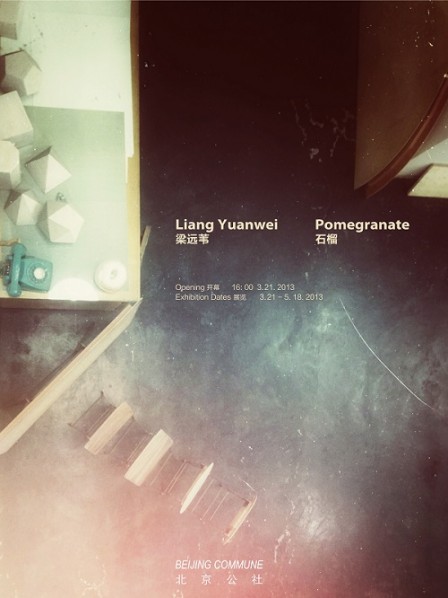
Beijing Commune is pleased to present Liang Yuanwei ’s solo exhibition “Pomegranate” featuring her latest work. It will be on view from March 21 through May 18.
Although Liang Yuanwei's practice is not limited to the canvas, she has made a name for herself with gorgeous paintings that mix the visual appeal of tapestries with the conceptual inclinations of American Minimalism. The Beijing artist was trained as a graphic designer and now works across media, including installation, photography and found objects. There is both self-discipline and wit at the foundation of her practice, evident since her early work, umustbestrong (2004), in which she used a typewriter to type 'umustbestrong' onto the length of an entire roll of two-ply toilet paper.
Liang is both protagonist and antagonist in the complex personal world she plays out on the canvas. In her first significant painting series Pieces of Life (2008), what looks at first glance to be a conventional approach to feminine beauty becomes more complex as one nears the canvas, where her rigorous painterly approach to self-cultivation and strict explorations of form come into focus. Motifs in the series are borrowed from swatches of fabric belonging to Liang, her family and friends. She reproduced twelve different patterns, including palm trees, flowers and geometric designs onto uniformly sized canvases both large and small. The artist explores light on canvas, and each one here has a field of colour with top-down gradient changes to the light, effecting a subtle three-dimensional depth. The motif is 'cut' into the thick field of paint, creating a negative space that is then filled in with colour.
Each canvas is completed in horizontal strips using a meticulous process requiring time-management, focus and control. Once begun, the painting cannot be abandoned until the strip is completed, which is often an eight-hour process or more, depending on the size of the canvas. One slip of the hand can lay ruin to many hours, days or weeks of work.
Liang is uninterested in representation or semiotics. Perception is via a flurry of delicate strokes on the canvas that manifest time's accumulation and the personal, even spiritual, experiences of the painter. While the formula might be simple, this extreme articulation of form exerts a strong sense of empathy in viewers.
As her painting has evolved, Liang has simplified her vocabulary to the single motif of an unassuming flower and her brushwork has become less restrained. Her paintings have grown to challengingly large sizes and are sometimes presented as pairs, with two contrasting fields of colour and with gradations of light progressing in opposite directions. These large canvases are contrasted with much smaller studies that surround them. The subtle or undisguised contrast between large and small works, between the uniformity dictated by her painting and the slight variations of hand, or the beauty of the finished canvas and the oppression of her working procedure add a contradiction and complexity to her work that led art critic and gallerist Leng Lin to praise her work as asserting a new 'cultural confidence' in Chinese art.
Liang's most recent works continue to explore form expanding on her vocabulary of visual vernacular, which includes household objects, folding tables, telephones, shoes or clocks. Beyond the analytical abilities demonstrated in these works, it is clear that her painting is endowed with temporal qualities that captivate far beyond their superficial elegance.
Text by Lee Ambrazy, quoted from "Althrough Liang yuanwei", <vitaminP2>, Phaidon Press.
About the exhibition
Address: 4 Jiuxianqiao Lu, Chaoyang District, Beijing
Tel: +86 (0)10-8456-2862
Courtesy of the artist and Beijing Commune, for further information please visit www.liangyuanwei.com.




























